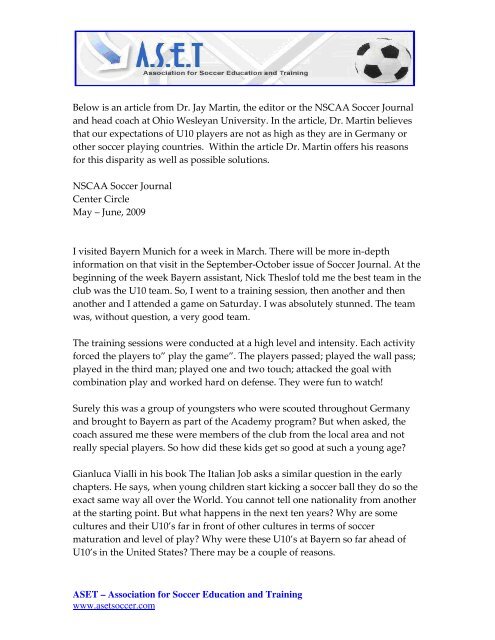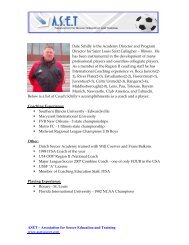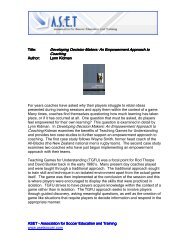Not so great expectations jay martin - Association for Soccer ...
Not so great expectations jay martin - Association for Soccer ...
Not so great expectations jay martin - Association for Soccer ...
Create successful ePaper yourself
Turn your PDF publications into a flip-book with our unique Google optimized e-Paper software.
Below is an article from Dr. Jay Martin, the editor or the NSCAA <strong>Soccer</strong> Journal<br />
and head coach at Ohio Wesleyan University. In the article, Dr. Martin believes<br />
that our <strong>expectations</strong> of U10 players are not as high as they are in Germany or<br />
other <strong>so</strong>ccer playing countries. Within the article Dr. Martin offers his rea<strong>so</strong>ns<br />
<strong>for</strong> this disparity as well as possible <strong>so</strong>lutions.<br />
NSCAA <strong>Soccer</strong> Journal<br />
Center Circle<br />
May – June, 2009<br />
I visited Bayern Munich <strong>for</strong> a week in March. There will be more in-depth<br />
in<strong>for</strong>mation on that visit in the September-October issue of <strong>Soccer</strong> Journal. At the<br />
beginning of the week Bayern assistant, Nick Theslof told me the best team in the<br />
club was the U10 team. So, I went to a training session, then another and then<br />
another and I attended a game on Saturday. I was ab<strong>so</strong>lutely stunned. The team<br />
was, without question, a very good team.<br />
The training sessions were conducted at a high level and intensity. Each activity<br />
<strong>for</strong>ced the players to” play the game”. The players passed; played the wall pass;<br />
played in the third man; played one and two touch; attacked the goal with<br />
combination play and worked hard on defense. They were fun to watch!<br />
Surely this was a group of youngsters who were scouted throughout Germany<br />
and brought to Bayern as part of the Academy program? But when asked, the<br />
coach assured me these were members of the club from the local area and not<br />
really special players. So how did these kids get <strong>so</strong> good at such a young age?<br />
Gianluca Vialli in his book The Italian Job asks a similar question in the early<br />
chapters. He says, when young children start kicking a <strong>so</strong>ccer ball they do <strong>so</strong> the<br />
exact same way all over the World. You cannot tell one nationality from another<br />
at the starting point. But what happens in the next ten years? Why are <strong>so</strong>me<br />
cultures and their U10’s far in front of other cultures in terms of <strong>so</strong>ccer<br />
maturation and level of play? Why were these U10’s at Bayern <strong>so</strong> far ahead of<br />
U10’s in the United States? There may be a couple of rea<strong>so</strong>ns.<br />
ASET – As<strong>so</strong>ciation <strong>for</strong> <strong>Soccer</strong> Education and Training<br />
www.aset<strong>so</strong>ccer.com
First, the Bayern U10’s have a tremendous group of role models. At Bayern, the<br />
U10’s get to train on the field adjacent to the first team. They see Phillip Lamm,<br />
Frank Ribery and Luca Toni train everyday. They carry those images to their<br />
training sessions and try to imitate their heroes. At one time, not long ago, that<br />
was a problem in this country. No one saw <strong>so</strong>ccer (as they did basketball and<br />
baseball) and no one had role models.<br />
But we should not have that problem today. Today in the US, we have role<br />
models <strong>for</strong> our players. There is more <strong>so</strong>ccer available at all levels <strong>for</strong> our young<br />
players to watch and imitate. That includes players in the US and from<br />
international teams. So I ask again, why doesn’t that kind of advanced play<br />
happen in the United States?<br />
Allow me to suggest a possible answer; our <strong>expectations</strong> of our U10’s are not as<br />
high as they are in Germany or other <strong>so</strong>ccer playing countries!! A perusal of<br />
<strong>so</strong>ccer curriculums on the Internet may support this statement. The<br />
characteristics of U10’s include selfishness, independent, short (but getting<br />
better) attention span etc. These characteristics lend themselves to dribbling,<br />
receiving the ball with your feet and maybe shooting with both feet. The focus is<br />
still the individual and combining with teammates and passing are not a priority.<br />
This is wrong. We must increase our <strong>expectations</strong> of young <strong>so</strong>ccer players.<br />
After watching the Bayern U10’s, it is clear that we can get more out of our<br />
young players. And, we must get more out of our young players.<br />
Research in many areas suggests that high <strong>expectations</strong> are important <strong>for</strong><br />
success. Academic <strong>expectations</strong> have been studied many times. Low <strong>expectations</strong><br />
reap low achievement; high <strong>expectations</strong> reap high achievement.<br />
Many coaches today feel that U10’s are not ready <strong>for</strong> passing, combining and one<br />
touch play. They want youth coaches to be patient and wait until the young<br />
players are ready. Why? Passing is an integral part of the game and should be<br />
taught and demonstrated early. This is not an indictment of any youth coach and<br />
his/her coaching, rather a concern that should be addressed by our <strong>so</strong>ccer<br />
culture.<br />
ASET – As<strong>so</strong>ciation <strong>for</strong> <strong>Soccer</strong> Education and Training<br />
www.aset<strong>so</strong>ccer.com
We tell ourselves that U10’s are not ready <strong>for</strong> advanced <strong>so</strong>ccer technique. Our<br />
<strong>expectations</strong> <strong>for</strong> these young players are too low. If, as a <strong>so</strong>ccer nation, we get<br />
behind the other international players at age 10 it stands to rea<strong>so</strong>n that we will<br />
always remain behind these players. While U10’s in Munich move <strong>for</strong>ward and<br />
incorporate tactics into their play, the U10’s in the US are still dribbling or<br />
standing in two lines passing.<br />
Part of this is due to our inferiority complex as a <strong>so</strong>ccer culture. We are <strong>so</strong><br />
concerned with our supposed lack of foot-eye coordination that we over do the<br />
early steps in the training process (i.e. dribbling, juggling etc.). It is time to move<br />
on from that mindset and push our young players.<br />
When I say push and suggest higher <strong>expectations</strong> I am not referring to winning.<br />
In fact, winning has nothing to do with these <strong>expectations</strong>; I am referring to<br />
playing, competing and expecting more from our young players on the field.<br />
Youth coaches spend a <strong>great</strong> deal of time teaching the basic fundamentals of<br />
<strong>so</strong>ccer because we feel our children need a longer introduction to “foot skills”. In<br />
our American culture “foot skills” do not come naturally as they might in<br />
Germany or Spain. But they do. Remember the scenario raised earlier by<br />
Gianluca Vialli. Children in all countries kick the ball the same way when they<br />
start. Then what happens? In many countries the young children begin to learn<br />
how to play. In the US we start to teach the children how to kick and dribble. I<br />
believe they already know how to per<strong>for</strong>m these skills. Let’s get the children<br />
playing the game and using and refining these skills. Children will refine these<br />
skills as they play because they will learn what is necessary to be successful.<br />
Remember how children learned by playing <strong>so</strong>ccer in the streets? When children<br />
play in the streets there are no lines; there is no standing around and all the<br />
children are playing whether it is even or uneven numbers on each team.<br />
Coaching schools urge us to replicate street <strong>so</strong>ccer in training.<br />
So, we should push our younger players. We should expect more from them. We<br />
should challenge the young players in training and devise ways and means to<br />
incorporate a number of skills in each training activity.<br />
ASET – As<strong>so</strong>ciation <strong>for</strong> <strong>Soccer</strong> Education and Training<br />
www.aset<strong>so</strong>ccer.com






